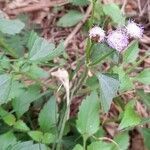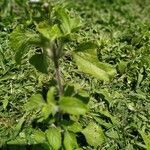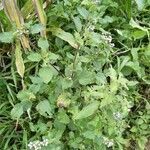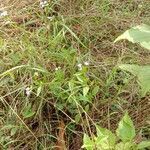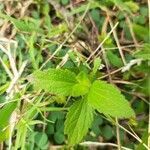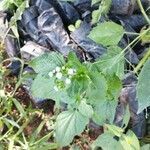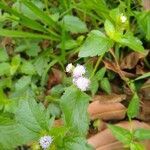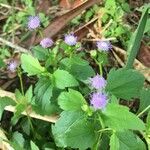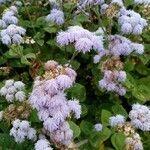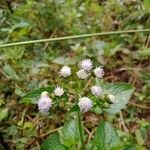Annual herb to 1 m tall, malodorous; stem erect to occasionally decumbent, terete, sparsely pilose and whitish pubescent, especially at nodes, to subglabrous.. Leaves opposite to occasionally sub-opposite above, with pubescent petiole 0.3–3 cm, blade ovate to rhomboid, 2.2–8.5 cm long, 1.2–6 cm wide, base obtuse, margins crenate to serrate, apex acute or obtuse, upper surface subglabrous to sparsely pilose, lower surface moderately pilose.. Inflorescence much branched, open, of 1–several bunches of ± 7–40 heads borne in open to dense cymose clusters on pubescent and pilose bracteolate peduncles; capitula 4–5 mm in diameter; stalks of individual capitula 2–12 mm, extending in fruit to 37 mm; phyllaries bi-seriate, green, ovate to oblong-lanceolate, usually 2-ribbed, outer series 3.5–4.5 mm long, 0.9–1 mm wide, inner slightly narrower, margins basally entire, erose to lacerate at apex, rarely entire, apex abruptly contracted to point, occasionally short-acuminate, often purple, glabrous to subglabrous to very sparesly pilose.. Florets 40–57, corolla tubular to sub-urceolate, 2–2.2 mm long, tube white, limb externally glabrous to sub-glabrous, lobes acute, blue, white, mauve, or purple; anthers basally rounded; style-arms blue, white, mauve or purple, exserted for 0.8–1.2 mm, papillate.. Achenes 1.2–1.8 mm long, glabrous between ribs; pappus of 5 triangular scales 1.9–2 mm long, acuminate into a slender awn (see note), margins scabrid.. Fig. 181/1–8 (page 828).
Annual herb to 1 m tall, malodorous; stem erect to occasionally decumbent, terete, sparsely pilose and whitish pubescent, especially at nodes, to subglabrous. Leaves opposite to occasionally sub-opposite above, with pubescent petiole 0.3-3 cm, blade ovate to rhomboid, 2.2-8.5 cm long, 1.2-6 cm wide, base obtuse, margins crenate to serrate, apex acute or obtuse, upper surface subglabrous to sparsely pilose, lower surface moderately pilose. Inflorescence much branched, open, of 1-several bunches of ± 7-40 heads borne in open to dense cymose clusters on pubescent and pilose bracteolate peduncles; capitula 4-5 mm in diameter; stalks of individual capitula 2-12 mm, extending in fruit to 37 mm; phyllaries bi-seriate, green, ovate to oblong-lanceolate, usually 2-ribbed, outer series 3.5-4.5 mm long, 0.9-1 mm wide, inner slightly narrower, margins basally entire, erose to lacerate at apex, rarely entire, apex abruptly contracted to point, occasionally short-acuminate, often purple, glabrous to subglabrous to very sparesly pilose. Florets 40-57, corolla tubular to sub-urceolate, 2-2.2 mm long, tube white, limb externally glabrous to sub-glabrous, lobes acute, blue, white, mauve, or purple; anthers basally rounded; style-arms blue, white, mauve or purple, exserted for 0.8-1.2 mm, papillate. Achenes 1.2-1.8 mm long, glabrous between ribs; pappus of 5 triangular scales 1.9-2 mm long, acuminate into a slender awn, margins scabrid.
Herbs, annual, 50-100 cm tall, sometimes less than 10 cm, with inconspicuous main root. Stems robust, ca. 4 cm in diam. at base, simple or branched from middle, stems and branches reddish, or green toward apex, white powdery puberulent or densely spreading long tomentose. Leaves often with axillary abortive buds; petiole 1-3 cm, densely white spreading villous; median leaves ovate, elliptic, or oblong, 3-8 × 2-5 cm; upper leaves gradually smaller, oblong, sometimes all leaves small, ca. 1 × 0.6 cm, both surfaces sparsely white puberulent and yellow gland-dotted, basally 3-veined or obscurely 5-veined, base obtuse or broadly cuneate, margin crenate-serrate, apex acute. Capitula small, 4-14, in dense terminal corymbs; peduncle 0.5-1.5 cm, powdery puberulent; involucre campanulate or hemispheric, ca. 5 mm in diam.; phyllaries 2-seriate, oblong or lanceolate-oblong, 3-4 mm, glabrous, margin lacerate; corollas 1.5-2.5 mm, glabrous or apically powdery puberulent; limb purplish, 5-lobed. Achenes black, 5-angled, 1.2-1.7 mm, sparsely white setuliferous; pappus scales 5 or awned, 1.5-3 mm. Fl. and fr. year-round. 2n = 20, 38, 40.
Annual herb, up to 1 m high; softly hairy. Leaves opposite, ovate, with large glandular spots on lower surface, base cuneate or obtuse, apex acute, margins crenate-dentate. Capitula discoid; many-flowered, in dense corymbs or occasionally a lax panicle; involucre campanulate; bracts in 2 or 3 rows, free, ribbed, with membranous margins. Receptacle honeycombed, conical. Corolla purple; tube cylindric below, campanulate above; lobes 5, much shorter than tube, glandular. Anthers obtuse at base, with oblong, apical appendage. Style terete, with short glandular branches. Flowering time June, Sept., Jan.? Pappus of 5 acuminate scales. Cypselae 5-ribbed, glabrous or short-setose on ribs; carpopodium usually large and asymmetrical.
Annuals, perennials, or sub-shrubs, 20–150 cm (fibrous-rooted). Stems erect, sparsely to densely villous. Leaf blades ovate to elliptic-oblong, 2–8 × 1–5 cm, margins toothed, abaxial faces sparsely pilose and gland-dotted. Peduncles minutely puberulent and sparsely to densely pilose, eglandular. Involucres 3–3.5 × 4–5 mm. Phyllaries oblong-lanceolate (0.8–1.2 mm wide), glabrous or sparsely pilose (margins often ciliate), eglandular, tips abruptly tapering, subulate, 0.5–1 mm. Corollas usually blue to lavender, sometimes white. Cypselae sparsely strigoso-hispidulous; pappi usually of scales 0.5–1.5(–3) mm, sometimes with tapering setae, rarely 0. 2n = 20, 40.
A small annual under shrub. It grows to 0.6 m tall and spreads to 1 m across. The stem is erect and branching. The leaves are oval and opposite. They are 6 cm long by 4 cm wide. They taper towards the tip and are hairy. The edges have teeth. The flowers are white and insignificant. They occur in small clusters at the ends of branches. The fruit are dry, black hairy capsules.
forming nearly 1/2 the width. Achenes ca. 1.2 mm long, with sparse short bristles usually restricted to the ribs; carpopodium asymmetrical; pappus of 5 large free scales, the scales usually lanceolate with long slender awns, to 2 mm long with awns.
Annual herb, up to 1 m high. Leaves opposite. Heads 4-5 mm across. Involucral bracts oblong, abruptly acuminate, erose, sparsely if at all hairy on back, hairs eglandular. Flowers purplish, bluish or white.
A faintly aromatic erect or procumbent annual herb 1-3 ft. high
Mauve florets in heads about 1/4 in. long
A common weed.
